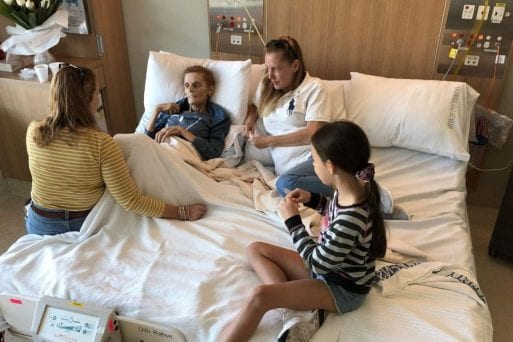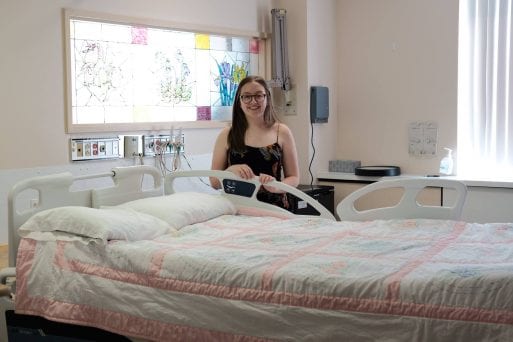
Josephine Collins lies in a Cuddle Bed with her family
Credit: Tom Forbes/ABC News
Two hospitals in Australia are offering dying patients a new option that is making an enormous difference at the end of their lives. Rather than spend their last days or hours lying alone in a tiny hospital bed, dying patients at Queensland’s Robina Hospital and Gold Coast University Hospital can enjoy the closeness of family members in one of the two hospitals’ palliative care units’ new Cuddle Beds.
A simple but innovative product, the Cuddle Bed is actually an oversized hospital bed, large enough to easily accommodate two or more adults. The brainchild of a mother who lost her 21-year old son and wished that she had been able to be physically closer to him at the end of his life, the beds are expensive — $10,000 according to one source. But the value they provide is priceless.
“She said to have this [cuddle bed] option would have been life-changing for her,” said occupational therapist Russel Plumbridge Jones, when speaking of the mother who inspired the idea.
The Importance of Physical Contact
People who are dying often feel isolated from the people around them, even when their loved ones are nearby. Some patients are heavily sedated and have trouble communicating, but they are still aware of their surroundings and in need of comfort– arguably more so than at any point in their lives. Being touched by another person enhances the production of the hormone oxytocin, which lowers the levels of other hormones related to stress. Physical touch has also been shown to promote sleep, lower blood pressure, and decrease feelings of isolation, anxiety and pain.

Sophie Peckford stands next to the hospital bed her fundraising efforts helped a local hospital purchase for its dying patients
Credit: Western Region Hospital Foundation via Facebook
But typical hospital beds allow little room for physical contact, as anyone who has spent time in one knows. Not only are they small, but the bed rails make it difficult for even a small person to lie down next to the patient and give them a hug. Most families make do with holding their loved one’s hands and sleep on uncomfortable recliners or cots in order to stay closeby.
But with the Cuddle Bed, even whole families can be close to the person who is dying while whispering their goodbyes. Husbands and wives can share small moments of intimacy. Children can lie next to a dying parent and be comforted by the physical presence of mom or dad. Most importantly, the dying person can feel the closeness of those who love them, which is a form of communication in and of itself.
That closeness helps the dying person “reconnect both physically and emotionally, so they feel like they can let go and [it’s] time to move on,” said Plumridge Jones.
More Cuddle Beds to Come
Despite the high price tag of the Cuddle Bed, palliative care units in Australia and now Canada are gearing up to buy more. In Queensland, Health Minister Steven Miles said in June that two more beds would be purchased soon. And following an enormously successful fundraising effort led by 18-year old high school student Sophie Peckford, the Western Memorial Regional Hospital in Corner Brook, Newfoundland, was able to purchase two Cuddle Beds for its palliative care unit earlier this year.
Hopefully, some hospitals in the United States will soon follow suit.

 Cuddle Beds Help Dying Patients Feel Less Alone
Cuddle Beds Help Dying Patients Feel Less Alone


 “Help Me, Helen”
“Help Me, Helen”

 “As Tears Go By” by Marianne Faithfull
“As Tears Go By” by Marianne Faithfull














